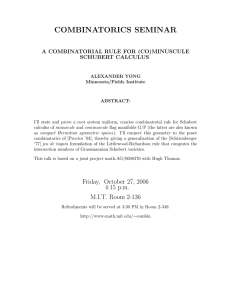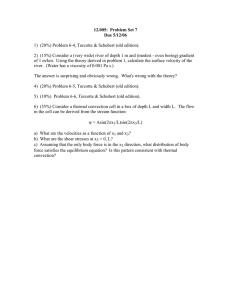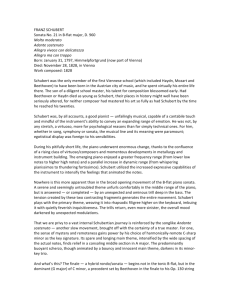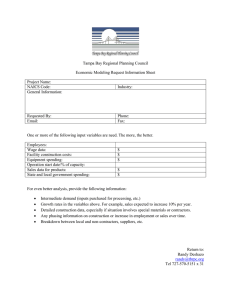Document 13967246
advertisement
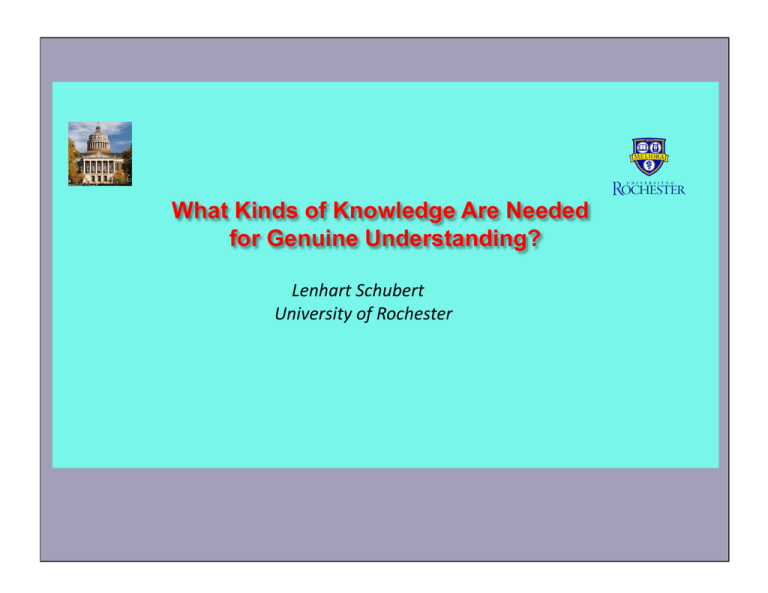
What Kinds of Knowledge Are Needed
for Genuine Understanding?
Lenhart Schubert University of Rochester
NLP in the 60’s to mid-80s
KEY INSIGHT:
Need large amounts of knowledge for genuine understanding/
inference/ problem solving.
“John had lunch at Mario’s.
The hamburger he ordered was tasteless,
so he left a small tip.”
Was John given a hamburger? Did he eat it? Where?
Who gave it to him? Was he satisfied with the food?
Why a small tip? For whom? Did he leave Mario’s?
PERCEIVED PROBLEMS
PARSING ACCURACY & COVERAGE
“John observed the bird with {binoculars/ yellow tail feathers/
delight/ fellow birders/ its brood of chicks/ …}”
KNOWLEDGE ACQUISITION BOTTLENECK
- ontological knowledge (Binoculars are a viewing instrument)
- well-known facts (Microsoft is a computer software/hardware company)
- general world knowledge (Restaurants serve meals to customers for pay).
SR/KR EXPRESSIVITY, CONGRUITY WITH LANGUAGE, AND REASONING POWER
- in the 80’s and 90’s this faded more and more from the NLP community’s purview
SUCCESSES: Where shallow methods suffice…
- speech recognition
- learning probabilistic grammars
- machine translation
- document retrieval
- text-based QA and summarization (in a sense)
- sentiment and topic analysis, etc.
The problems of genuine understanding, general dialogue, reasoning,
and problem-solving remain (almost) as challenging as ever!
“Peripheral” advances: speech recognition, input parsing
(to some extent), corpus-based factoid & rule gathering,
evaluation methodologies
4
An Example of genuine understanding and reasoning
Alicia drove home from her holiday visit to the US.
What border(s) did she cross in her drive?
Visiting a place generally entails having one's current place of
residence away from that place, going to it, staying there in
the expectation of some immediate rewards, and then leaving
it, typically going back to one's place of residence.
“Home” is a person's permanent place of residence.
The US is a country, and leaving a country entails crossing its border.
Driving takes place on land.
The only land borders of the US are with Canada and Mexico.
Along with lexical and paraphrase knowledge #
Alicia crossed the border with Canada OR Mexico
(and perhaps others, e.g., from Mexico into Guatemala).
Also, it's quite possible that Alicia is a resident of Canada or Mexico,
and that she is a citizen of one of those countries.
A (still) more demanding example
When Randy learned that his metastatic cancer was terminal, he decided to stop receiving
chemotherapy and enrol in a hospice program designed to provide palliative care.
Why did Randy decide this?
When you learn something, you then know it;
(so Randy knew he had terminal metastatic cancer);
When someone learns (or knows) that something is the case, it is indeed the case;
(so Randy had terminal metastatic cancer).
Terminal metastatic cancer is usually fatal within a few months;
(thus Randy was destined to die within a few months);
Chemotherapy is intended to combat cancer and prolong life,
but results in suffering and weakness;
No medical treatment will significantly prolong a terminal cancer patient's life;
chemotherapy is a medical treatment;
Stopping something entails it was going on;
(so Randy had been receiving chemotherapy, and therefore had endured suffering);
Receiving palliative care reduces pain and discomfort;
Enrolling in a program to provide certain services will lead to receiving those services;
(so Randy would receive palliative care);
If Randy continued receiving chemotherapy, he would endure further suffering
without significant life extension, while palliative care would make him feel better;
People act to optimize expected rewards and minimize suffering;
so if Randy knew all of the above, his choice of palliative care instead of chemotherapy is explained.
Example continued
How did Randy know all this?
Commonsense inferences that "jump out” at me also "jump out" at others
(who possess the same premise knowledge) – “simulative inference”
All the items above are common knowledge (especially to cancer patients),
so the indicated inferences were just as obvious to Randy as they are to me;
So the presumption previously underscored (Randy knew/inferred all those facts)
surely holds, and Randy's choice is explained.
(Again, we're also presupposing a lot of lexical & paraphrase knowledge:
“terminal” illness, “fatal” condition, “medical treatment”, “palliative care”,
“optimize”, “life extension”, “suffering”, etc.)
Expressive devices encountered in the two examples: Predica7on, of course (Alicia visited the US, the US is a country, and so on) Temporally related events (driving somewhere, staying, returning) and their implicit consequences (crossing borders, enjoyment) Causal rela7ons (chemotherapy causes suffering, possible life prolonga@on) Geographic rela7onships (perhaps dependent on "mental maps") Conjunc7on and disjunc7on (the US borders on Canada and Mexico; Alicia drove into Canada or Mexico) Nega7on (if you leave a place, you are then not in that place; not receiving significant benefits from chemotherapy) Quan7fica7on (almost everyone knows that chemotherapy is used to treat cancer; no medical treatment will significantly prolong a terminal cancer pa@ent's life; And that’s not all … Further demands on expressivity
Genericity -- almost all the general knowledge listed has the character of applying
in “typical” cases, but allowing for exceptions;
Patterns of behavior (holiday trips; the usual course of events if you get cancer);
this is of course generic knowledge;
Modal/mental notions (learning, knowing, expecting, deciding, inferring, intending, …)
Counterfactuals (deciding against something because of the adverse consequences
it would have);
Uncertainty (Alicia's probable home country, Randy's life expectancy)
Predicate modification (terminal metastatic cancer, palliative care, continuing/stopping
receiving chemotherapy, feel better)
Sentence modification (probably, Alicia lives in Canada or in Mexico; possibly she
lives in Guatemala)
Predicate reification (driving takes place on land; palliative care reduces suffering)
Sentence reification (Randy learned that his metastatic cancer was terminal)
Are any of these devices peculiar to English?
These devices are available in all languages!
A cultural accident, or a reflection of our “mentalese” semantic types?
Language and thought are conjectured to have arisen concurrently
(e.g., Ian Tattersall, Derek Bickerton, Philip Lieberman, and many others);
Humans occupy the “cognitive niche” (Pinker) because they can learn,
store, manipulate for inference, & communicate meaningful symbolic
patterns -- semantic / knowledge representations
Richard Montague showed that there is a tight relationship between
linguistic structure and meaning.
So, surely it is reasonable to view language as a mirror of mind;
i.e., “mentalese” as language-like, and as richly expressive.
Candidates for seman8c representa8on and knowledge representa8on (discussed & cri@qued in Schubert, AAAI '15; cri@cisms here are “caricatures”) FOL, DRT (e.g., Allen, Jurafsky & Mar@n, Kamp, Heim, J. Bos, ...) [expressively inadequate] Seman8c nets (wide spectrum: Shapiro, Sowa, Schubert, ConceptNet, ...); [any nota@on can be cast as SN] Descrip8on logics (CLASSIC, LOOM, OWL-­‐DL, KAON, SROIQ, ...) [expressively inadequate] Conceptual meaning representa8ons (Schank's CD, Jackendoff, FrameNet, ...) [expr./infer. inadequate] Thema8c role representa8ons (e.g., Palmer, Gildea, & Xue ’10) [expr./infer. inadequate] Abstract meaning representa8on (AMR) (Banarescu et al. '13) [inferen@ally inadequate] Hobbs' "flat" representa8on (Hobbs '06) [conflates dis@nct types] Structured English (e.g., MacCartney & Manning '09, Dagan et al. '08, …); [ambiguous, inferen@ally inadequate] Montague Grammar (English as logic) (e.g., Dowty '79, Chierchia & McConnell-­‐Ginet '00); [unnecessarily complex, higher-­‐order] Extensional Montague fragments (e.g., McAllester & Divan '92, Artzi & Zeqlemoyer '13); [expressively inadequate] DCS trees (Liang et al. '11); [expressively inadequate] Situa8on seman8cs (Reichenbach '47, Barwise & Perry '83) [abstruse, inferen@ally inadequate] Episodic Logic (EL) [remedies many of these flaws; s@ll briqle, lacks adequate KB] Episodic Logic (EL) – Montague-inspired, first-order, situational, intensional
A language-like, first-order SR/KR with a small number of types (but abstract individuals);
LFs are obtained compositionally from phrase structure trees;
Handles most semantic phenomena shared by NLs; all types of referents;
allows complex situations/events, with temporal/causal relations
John donated blood to the Red Cross.
[John1 <past donate.v> (K blood.n) Red_Cross] {initial representation}
(some e: [e before Now3]
Skolemize, split [E1.sk before Now3], [Blood1.sk blood.n],
(some x: [x blood.n]
[[John1 donate.v
[[John1 donate.v x Red_Cross1] ** e]
Blood1.sk Red_Cross1] ** E1.sk ]
Very few people still debate the fact that the earth is heating up {final representation}:
[Fact4.sk fact.n],
[Fact4.sk = (that (some e0: [e0 at-about Now0]
[(The z [z earth.n] [z heat_up.v]) ** e0]))],
((fquan (very.adv few.a)) x: [x (plur person.n)] (still.adv (l v [v debate.v Fact4.sk])))
Unfortunately, faulty/underspecified syntactic analyses lead to faulty LFs.
We don’t have enough (reliable) semantic pattern knowledge.
The EPILOG system for Episodic Logic (L. Schubert, C.-­‐H. Hwang, S. Schaeffer, F. Morbini, Purtee, ...) “A car crashed into a tree. …”
(some e: [e before Now34]
(some x: [x car] (some y: [y tree]
[[x crash-into y] ** e])))
color meta number
episode
string
set
EPILOG core reasoner Specialist
Interface
hier2
time
type
LOGICAL INPUT
other
LOGICAL OUTPUT
“The driver of x may
be hurt or killed”
equality parts
KNOWLEDGE
Expressive richness does not impede inference: EPILOG 2 holds its own on large FOL problems (Morbini & Schubert ’09); but inference remains briqle; uncertainty handling is heuris@c; KB remains inadequate Example using “most” (from J.F. Allen’s ‘Monroe emergency’ domain):
Most front loaders are currently in use;
Whatever equipment is in use in unavailable;
Front loaders are equipment
Therefore, most front loaders are currently unavailable.
(most x: [x front-loader] [[x in-use] @ Now3]);
(all x: [x equipment] (all e [[[x in-use] @ e] => [(not [x available]) @ e]]));
(all x: [x front-loader] [x equipment])
(most x: [x front-loader] [(not [x available]) @ Now3])
Example involving attitudes (English glosses of EL formulas)
Alice found out that Mark Twain is the same as Samuel Clemens.
When someone finds out something, s/he doesn’t know it to be true at
the beginning (of the finding-out event) but knows it to be true at the end.
Therefore:
- Alice didn’t know (before finding out) that Mark Twain is the same
as Samual Clemens;
- Alice knew afterwards that Mark Twain is the same as Samuel Clemens;
- Mark Twain is the same as Samuel Clemens (from knowing-axioms).
EPILOG inference resembles Natural Logic (Nlog) but is more general. An example beyond the scope of Nlog (again from Allen's Monroe domain): Every available crane can be used to hoist rubble onto a truck. The small crane, which is on Clinton Ave, is not in use. Therefore: the small crane can be used to hoist rubble from the collapsed building on Penfield Rd onto a truck. Every available crane can be used to hoist rubble onto a truck (s '(all x (x ((aqr available) crane)) (all r (r rubble) ((that (some y (y person) (some z (z truck) (y (adv-­‐a (for-­‐purpose (Ka (adv-­‐a (onto z) (hoist r)))) (use x)))))) possible)))) The small crane, on Clinton Ave., is not in use. (s '(the x (x ((aqr small) crane)) ((x on Clinton-­‐Ave) and (not (x in-­‐use))))) Every crane is a device (s '(all x (x crane) (x device))) Every device that is not in use is available (s ‘(all x ((x device) and (not (x in-­‐use))) (x available))) Can the small crane be used to hoist rubble from the collapsed building on Penfield Rd onto a truck? (Answered affirma7vely by EPILOG in .127 sec) (q (p ‘(the x (x ((aqr small) crane)) (some r ((r rubble) and (the s ((s (aqr collapsed building)) and (s on Penfield-­‐Rd)) (r from s))) ((that (some y (y person) (some z (z truck) (y (adv-­‐a (for-­‐purpose (Ka (adv-­‐a (onto z) (hoist r)))) (use x)))))) possible))))) Types of knowledge required PaUerns of predica8on: for parser guidance e.g., person see bird; see with viewing instruments; bird with feathers; tail feathers; colored feathers Disambiguate “He saw a bird with {binoculars | yellow tail feathers}” PaUerns of ac8ons/events and rela8onships: for expanding /connec@ng sentences e.g., Dyn-­‐schema [Person x visits foreign-­‐country y] (episode e): Init-­‐conds: [x loc-­‐at u:<some (place in (home-­‐country-­‐of y))>] (episode e1), Co-­‐conds: [x have v:<some (travel paraphernalia for y e)>] (episode e2), Steps: [x travel from u to w:<some (place in y)>] (episode e3), [x do some ac@vi@es in y] (episode e4), [x travel from z:<some (place in y)> to u] (episode e5) Effects: [x obtain g:<some (gra@fica@on-­‐from e4)>] (episode e6) Constr: [e = ( join-­‐of e3 e4 e5 e6)], [e1 starts e], [e2 same-­‐@me e], [e3 consec e4 e5], [e6 during e4] Similarly, possible paqerns of events for cancer pa@ent diagnosis, surgery, chemo, …) Similarly, “object u@lity” paqerns (what can you do with an apple? a pen? a car? …) Similarly, “disposi@onal” paqerns (dogs bark; fragile object tend to break on impact) Inference based on paUerns and schemas seems to have the character match certain parts tenta@vely infer the whole Types of knowledge, cont’d Lexical and paraphrase knowledge e.g., dogs are land mammals; pens are wri@ng instruments; trees are plants with a tall wooden trunk and a branched canopy …; to kill is to render dead; to walk is to advance on foot; managing to do x entails doing x; x sells y to z z buys y from z; make good money earn well be well compensated pull in the bucks; Condi8onal/generic world knowledge e.g., if you drop an object, it will hit whatever is directly beneath it; most dogs are someone’s pet; dogs are generally friendly; chemotherapy tends to cause nausea and hair loss; … Specialist knowledge: taxonomies, partonomies, temporal rela@ons, arithme@c & scales, geometric/imagis@c representa@ons, sets, symbolic expressions (incl. language), … Some aKempts to address the “Knowledge AcquisiPon BoKleneck” We have plenty of textual “knowledge”, but liqle -­‐ schema@c paqern knowledge for understanding (and behavior); -­‐ “if-­‐then” lexical and world knowledge for reasoning! Past and ongoing efforts in my Rochester group: KNEXT – knowledge extrac@on from text, aimed at general factoids (typically, paqerns of predica@on) “Sharpening” and abstrac@ng of KNEXT factoids into quan@fied generaliza@ons (Lore, successor to KNEXT) Lexical knowledge engineering (par@ally automated), esp. for frequent and “primi@ve” verbs, several VerbNet classes, implica@ves, a•tudinal verbs Automa@c WordNet gloss interpreta@on (in progress) Computer-­‐graphics-­‐based object/scene representa@on & inference Experimental schema engineering, to assess syntac@c/seman@c requirements Schema learning (future work) KNEXT architecture
sentence & phrase
structure
identify
temporal
phrases, etc.
80 regular
phrase patterns,
paired with semantic rules
proper name
gazetteer; “of”knowledge,
etc.
[S [NP I] [VP had [NP a terrible flu] [NP last year]]]
adjust phrase
Structure for
Interpretation
adjusted input
[S [NP I] [VP had [NP a terrible flu] [NPtime last year]]]
compute LFs
sets of LFs
[mePron haveV fluN], <a{n} λx[x (attr terribleA fluN)]> extract & abstract
propositions
propositional LFs
verbalize
and filter
propositions
[<a{n} personN> haveV fluN],
[<a{n} fluN> terribleA] [<a{n} personN> haveV fluN], [<a{n} fluN> terribleA]
abstract LFs and
English output
A PERSON MAY HAVE A FLU
A FLU CAN BE TERRIBLE
“shallow”
knowledge
9
“Sharpening” KNEXT factoids
(using transduction patterns,
semantic info from WordNet,
VerbNet, etc.)
E.g., A person may have hair
All or most persons
permanently have some
hair as part
(all-or-most x: [x person]
(some e: [(x . e) permanent]
(some y: [y hair]
[[x have-as-part y] ** e])))
Sample inferences:
Dana is a person
Probably, Dana permanently
has some hair as part.
(probably
(some e: [(Dana . e) permanent]
(some y: [y hair]
[[Dana has-as-part y] ** e])))
ACME is a company
Probably, ACME occasionally
announces a product.
(probably
(occasional e
(some y: [y product]
[[ACME announce y] ** e])))
~150 “primiPve” verbal concepts, with axioms (MOVE, GRASP, SEE, LEARN, MAKE, ASK-­‐OF, CONVEY-­‐INFO-­‐TO, WANT-­‐TBT, …) Several hundred axioms for VerbNet classes (e.g., state-­‐change concepts like BREAK, REPAIR, MELT, etc.) in terms of “primi@ves” and “predicate parameters”, inserted into 2-­‐4 axiom schemas per class) WordNet: 77,000 formal axioms derived from WN nominal hierarchy (used mass/count dis@nc@on and various other features to dis@nguish the rela@on between pairs like <seawater, water> all seawater is water, and like <gold, noble_metal> gold (the kind of stuff) is a noble_metal ) Gloss interpretaPon (in progress): E.g., x slam2.v y in event e x violently strike1.v y, and x is probably a person and y is probably a thing12.n (physical en7ty). Problems: Many glosses are quasi-­‐circular (admire feel admira7on for), don’t apply to al synset members, and don’t provide major entailments (like, dying results in being dead!) Graphics-­‐based scene modeling in first-­‐reader stories: Rosy and Frank see the nest in the apple tree. Why can’t they tell whether there are eggs in the nest? Visual occlusion by the nest itself! Current preliminary schema work: experimen@ng with schema syntax (like the “visi@ng a foreign country” example), to be used as target formalism for learning schemas from text. Concluding comments
Reliable semantic parsing requires reliable syntactic parsing;
need guidance by patterns of predication, modification, etc. (KNEXT-like)
EL provides an expressively adequate representation close to language
Inference methods beyond those of FOL are implemented
Probabilistic inference remains ad hoc
KA bottleneck is under attack, but far from vanquished;
schemas (containing EL formulas) seem to be the kind of “soft”
representation that will support genuine understanding, reasoning
Publications (from my web page, http://www.cs.rochester.edu/u/schubert/)
•
L.K. Schubert, "Semantic representation", 29th AAAI Conference (AAAI15), Jan. 25-30, 2015, Austin, TX. Slides of the talk.
•
E. Bigelow, D. Scarafoni, L. Schubert, and A. Wilson, "On the need for imagistic modeling in story understanding", Biologically
Inspired Cognitive Architectures 11, Jan. 2015, 22--28. (Presented at Ann. Int. Conf. on Biologically Inspired Computing
Architectures (BICA 2014), Nov. 7-9, MIT, Cambridge, MA, 2014.)
•
L.K. Schubert, Computational linguistics", in Edward N. Zalta (Principal Editor), Stanford Encyclopedia of Philosophy, CSLI,
Stanford, CA.(100pp), 2014. L.K. Schubert, "From Treebank parses to Episodic Logic and commonsense inference", Proc. of the
ACL 2014 Workshop on Semantic Parsing, Baltimore, MD, June 26, ACL, 55-60.
•
L.K. Schubert, "NLog-like inference and commonsense reasoning", in A. Zaenen, V. de Paiva, & C. Condoravdi (eds.),
Semantics for Textual Inference, special issue of Linguistic Issues in Language Technology (LiLT) 9(9), 2013. (The pdf file is a
preliminary version, Dept. of Computer Science, University of Rochester, Oct. 2012.)
•
J. Gordon and L.K. Schubert, WordNet hierarchy axiomatization and the mass-count distinction", 7th IEEE Int. Conf. on
Semantic Computing (ICSC 2013), September 16-18, Irvine, CA, 2013.
•
A. Purtee and L.K. Schubert, "TTT: A tree transduction language for syntactic and semantic processing", EACL 2012 Workshop
on Applications of Tree Automata Techniques in Natural Language Processing (ATANLP 2012), Avignon, France, Apr. 24, 2012.
•
K. Stratos, L.K. Schubert, & J. Gordon, "Episodic Logic: Natural Logic + reasoning", Int. Conf. on Knowledge Engineering and
Ontology Development, (KEOD'11), Oct 26-29, Paris, 2011.
•
Jonathan Gordon and Lenhart Schubert, "Quantificational sharpening of commonsense knowledge", Proc. of the AAAI Fall
Symposium on Commonsense Knowledge, Arlington, VA, Nov. 11-13, 2010. L.K. Schubert, "From generic sentences to scripts",
IJCAI'09 Workshop W22, Logic and the Simulation of Interaction and Reasoning (LSIR 2), Pasadena, CA, July 12, 2009.
•
F. Morbini and L.K. Schubert, "Evaluation of Epilog: A reasoner for Episodic Logic", Commonsense'09, June 1-3, 2009, Toronto,
Canada. Also available at http://commonsensereasoning.org/2009/papers.html
•
Benjamin Van Durme and Lenhart K. Schubert,
"Open knowledge extraction using compositional language processing", Symposium on Semantics in Systems for
Text Processing (STEP 2008), September 22-24, 2008 - Venice, Italy.
•
A.N. Kaplan and L.K. Schubert, "A computational model of belief", Artificial Intelligence 120(1), June 2000, 119-160.
•
L.K. Schubert and C.H. Hwang,
"Episodic Logic meets Little Red Riding Hood: A comprehensive, natural representation for language understanding",
in L. Iwanska and S.C. Shapiro (eds.), Natural Language Processing and Knowledge Representation: Language for
Knowledge and Knowledge for Language, MIT/AAAI Press, Menlo Park, CA, and Cambridge, MA, 2000, 111-174.
